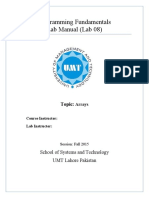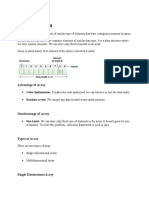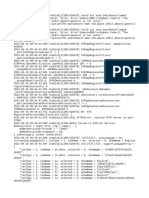Array Basics: Exercise 1
Array Basics: Exercise 1
Uploaded by
freddy the gamerCopyright:
Available Formats
Array Basics: Exercise 1
Array Basics: Exercise 1
Uploaded by
freddy the gamerOriginal Title
Copyright
Available Formats
Share this document
Did you find this document useful?
Is this content inappropriate?
Copyright:
Available Formats
Array Basics: Exercise 1
Array Basics: Exercise 1
Uploaded by
freddy the gamerCopyright:
Available Formats
AP Computer Science justin smith
Array Basics
Content
Uses of pre-built data structures
An array is a data structure that is available for a programmer to use in Java. You will find that there are
situations where arrays will work perfectly for your program and they will facilitate finding a solution. Other
times an array might not be the best data structure to use and you might have to use something different.
As you complete this activity, think carefully about how arrays could be used in your future programs.
For each of the following questions, write the appropriate code in your notebook (you will need to have
this exercise in your notebook to receive full credit during notebook checks). Using your array whiteboard
and markers, construct a model of the object constructed by Java.
To get full credit on this assignment, you must record your answers in your notebook and construct
models of the arrays using the whiteboard or papers given to you. Your instructor will be checking to
make sure you are able to model array construction using the modeling materials provided to you.
Exercise 1 (Example)
Construct an array that stores 8 elements of type int. Don’t forget to show how Java auto-initializes your
elements!
int[] array = new int[8];
Exercise 2: Constructing & Traversing Arrays
Problem 2a.
Using indexes, assign values to each element of your array.
array[0] = 8;
array[1] = 7;
array[2] = -3;
This work is licensed under a Creative Commons Attribution-
NonCommercial-ShareAlike 4.0 International License
AP Computer Science
Problem 2b.
Write code that will declare a new array with 6 values and initialize the them to non-default values.
int[] newArray = {8,6,7,5,3,0}
Problem 2c.
Generate code that constructs an array with 5 elements, and fills the array with 5 consecutive integers.
int array3 = new int[5];
for(int i=0; i<5; i++){
array3[i] = i;
}
Problem 2d.
Construct a loop that will grab input from the user and traverse the array to fill it in.
scanner input = new Scanner(System.in);
int[] array4 = new int[10];
for(int i=0; i<10; i++){Int
array4[i] = input.next();
}
Problem 2e.
Using only one statement, declare an array of six integer values: -4, 19, 3, 20, 72, 58.
This work is licensed under a Creative Commons Attribution-
NonCommercial-ShareAlike 4.0 International License
AP Computer Science
Exercise 3. Accessing Arrays
For each of the following problems, you should write the code, then work to trace the flow of control and
model where and how Java accesses the array.
Problem 3a.
Using array.length, write code that will output the last value of the array you constructed in Problem 2d.
Hint: Don’t forget to use 0-based indexing!
System.out.printIn(array4[array4.length-1]);
Problem 3b.
Generate code to output the middle value of the array you wrote in Problem 2d.
for(int i=0; i<10; i++){Int
Problem 3c.
Using the array you wrote in Problem 2d, write code that decrements each element by 1.
for(int i=0; i<array4.length; i++){
Problem 3d.
Write code that creates an array named data, with the following contents:
data
1 4 9 16 25
0 1 2 3 4
array[0] = 1;
array[1] = 2;
array[2] = 9;
array[3] = 16;
array[4] = 25;
Problem 3e.
Construct an array called even that stores the first 499 even integers starting at 0
int array0 = new int[499];
for(int i=0; i<499; i++){
This work is licensed under a Creative Commons Attribution-
NonCommercial-ShareAlike 4.0 International License
AP Computer Science
Problem 3f.
Write code that will output the value at index 100 in array even.
for(int i=0; i<100; i++){
Problem 3g.
Write code that accesses array even and outputs the value at indexes 278 and 456.
int array2 = new int[278];
for(int i=0; i<278; i++){
array2[i] = i;
}
int array4 = new int[456];
for(int i=0; i<456; i++){
array4[i] = i;
}
Problem 3h.
Write a method that stores all odd numbers between -4 and 5 into an array using a loop. Make the
array’s size exactly large enough to store the numbers (including -4 and 5).
scanner input = new Scanner(System.in);
int[] array4 = new int[5];
for(int i=-4; i<5; i++){Int
array4[i] = input.next();
}
Problem 3i.
Try generalizing your code from Problem 3h so that it will work for any minimum and maximum values,
not just -4 and 5. To test your generalized code, use the modeling supplies to test out your code using
different values.
int[] array4 = new int[5];
for(int i=0; i<5; i++){
array4[i] = i;
}
}
}
This work is licensed under a Creative Commons Attribution-
NonCommercial-ShareAlike 4.0 International License
You might also like
- Sap HR/HCM: Cross Application Time SheetDocument4 pagesSap HR/HCM: Cross Application Time Sheetclaoker100% (2)
- PMKID AttackDocument21 pagesPMKID AttackMarcelo JuniorNo ratings yet
- Data Lab Student Guide Part 1Document6 pagesData Lab Student Guide Part 1freddy the gamerNo ratings yet
- Does This Apply To Your Client? Circle One: Yes NoDocument2 pagesDoes This Apply To Your Client? Circle One: Yes Nofreddy the gamer100% (1)
- Mid Term Exam Semester 1Document14 pagesMid Term Exam Semester 1Emanuel Petcu0% (1)
- JESD220BDocument366 pagesJESD220BVinod BoreddyNo ratings yet
- Array Basics: Exercise 1Document4 pagesArray Basics: Exercise 1freddy the gamerNo ratings yet
- Inft231101081 Oop Lab 5Document11 pagesInft231101081 Oop Lab 5Muhammad HaziqNo ratings yet
- What Is An Array (Java)Document7 pagesWhat Is An Array (Java)Jose Luis Becerril BurgosNo ratings yet
- Lab 8 Arrays I: EKT 120 - Computer Programming Laboratory ModuleDocument9 pagesLab 8 Arrays I: EKT 120 - Computer Programming Laboratory Moduleariff mohdNo ratings yet
- CJ Unit 4Document39 pagesCJ Unit 4Esha WorlikarNo ratings yet
- Computer Prog2Document68 pagesComputer Prog2Erika Pareñas TecsonNo ratings yet
- DSA Lab 05 SPRING 2022 SEDocument17 pagesDSA Lab 05 SPRING 2022 SEMehmood SheikhNo ratings yet
- Programming Fundamentals Lab 08 (1D Array)Document5 pagesProgramming Fundamentals Lab 08 (1D Array)Ahmad AbduhuNo ratings yet
- EXERCISE 1: What Is The Result From The Array? ProgramDocument6 pagesEXERCISE 1: What Is The Result From The Array? ProgramDinesh KumarNo ratings yet
- Nafis Java - ManualDocument88 pagesNafis Java - ManualThe RockyFFNo ratings yet
- Week 6Document13 pagesWeek 6UniCornNo ratings yet
- CS 202: IT Workshop I Assignment III (Group: G21, G23) Total Marks: 30Document1 pageCS 202: IT Workshop I Assignment III (Group: G21, G23) Total Marks: 30varuneshaaNo ratings yet
- 0llcomputer Applications ICSE 10th Answer Organized 1Document86 pages0llcomputer Applications ICSE 10th Answer Organized 1RaghavNo ratings yet
- Programming Language (JAVA) : Unit 6.4 - Basics of ArrayDocument27 pagesProgramming Language (JAVA) : Unit 6.4 - Basics of ArrayJefree AcconNo ratings yet
- Unit-I - 2arrays in JAVADocument18 pagesUnit-I - 2arrays in JAVAMochiNo ratings yet
- 5.1 Java Arrays12Document13 pages5.1 Java Arrays12mrnirajbroNo ratings yet
- Essential Java ClassesDocument16 pagesEssential Java ClassesAnonymous IhmXvCHj3cNo ratings yet
- Chapter FourDocument49 pagesChapter Fourmuhidinhawlet76No ratings yet
- Chapter4 ArraysDocument57 pagesChapter4 Arrayssuccess SuccessNo ratings yet
- Tutorial 5Document6 pagesTutorial 5lz13424792186No ratings yet
- Notes5 Java ArraysDocument5 pagesNotes5 Java Arraysseniorhigh LISNo ratings yet
- JF 6 1 PracticeDocument4 pagesJF 6 1 PracticeNour MeniiNo ratings yet
- 3 Methods in JavaDocument24 pages3 Methods in JavaPM 2014 1st year summer studentsNo ratings yet
- WT File 2nd PartDocument7 pagesWT File 2nd PartVishal ShahNo ratings yet
- Asgment 3Document2 pagesAsgment 3anon-951986No ratings yet
- Exercises - 1 - Arrays - ExercisesDocument2 pagesExercises - 1 - Arrays - ExercisesKavya PandyaNo ratings yet
- Week 7: C#ZoneDocument16 pagesWeek 7: C#ZoneNimra KarimNo ratings yet
- Arrays (1D, 2D, 3D)Document20 pagesArrays (1D, 2D, 3D)atiq.rehman1105No ratings yet
- Day 9 and 10Document9 pagesDay 9 and 10IrfanNo ratings yet
- Computer Application - X Test 5 Total - 100 Time:2:00HDocument2 pagesComputer Application - X Test 5 Total - 100 Time:2:00HAtanuBhandaryNo ratings yet
- JF 6 1 PracticeDocument4 pagesJF 6 1 PracticeBabycNo ratings yet
- OOPS Lab ManualDocument69 pagesOOPS Lab Manual28254.anubhavNo ratings yet
- JAVA ArraysDocument37 pagesJAVA Arraysbt5112 KareenaNo ratings yet
- Lab Manual - 5: CLO No. Learning Outcomes Assessment Item BT Level PLODocument14 pagesLab Manual - 5: CLO No. Learning Outcomes Assessment Item BT Level PLORajaishNo ratings yet
- Array in JavaDocument9 pagesArray in Javaabdulrcr334No ratings yet
- CSP Lab Manual 9Document11 pagesCSP Lab Manual 9ẄâQâŗÂlïNo ratings yet
- ArrayDocument12 pagesArrayPrachiNo ratings yet
- ch05 (1) - ArraysDocument17 pagesch05 (1) - ArraysSamantha MorinNo ratings yet
- Lecture 9Document27 pagesLecture 9muhammedhassann18No ratings yet
- ArraysDocument3 pagesArraysnpapnNo ratings yet
- Java Basics Unit 2Document94 pagesJava Basics Unit 2afnaan31250No ratings yet
- Lecture 9 Arrays IDocument27 pagesLecture 9 Arrays IMahmoud HossamNo ratings yet
- C ArrayDocument6 pagesC ArraychayasappuNo ratings yet
- Python by DR SabDocument14 pagesPython by DR SabDukkyNo ratings yet
- Two Dimensional Array in Java - JavaTutoring-porDocument6 pagesTwo Dimensional Array in Java - JavaTutoring-porJohnmark PadillaNo ratings yet
- ArraysDocument10 pagesArraysC.Rajendra Prasad100% (1)
- John Llyod EDocument5 pagesJohn Llyod Eetackenneth961No ratings yet
- Lecture 4Document18 pagesLecture 4abhishek kumar bhaugeeruthyNo ratings yet
- Chapter7 - Arrays (Programming I)Document79 pagesChapter7 - Arrays (Programming I)Aziemah HaidahNo ratings yet
- COMPROG2 WEEK2 - SESSION 2 - StudentDocument24 pagesCOMPROG2 WEEK2 - SESSION 2 - StudentLea Angelica ManliguezNo ratings yet
- M3-Lesson 4 - One-Dimensional ArrayDocument12 pagesM3-Lesson 4 - One-Dimensional ArraycababatvicenteNo ratings yet
- Java Array Interview Questions and AnswersDocument23 pagesJava Array Interview Questions and AnswersAditya IngaleNo ratings yet
- Experiment 3Document5 pagesExperiment 3khatibmohammed201No ratings yet
- ArrayDocument61 pagesArraysiti_ismail_61No ratings yet
- Array in JavaDocument8 pagesArray in JavasONy MCNo ratings yet
- Programming Language Using Java IIDocument57 pagesProgramming Language Using Java IIt7141145No ratings yet
- Chapter 2 Java Arrays 2024 - NewDocument47 pagesChapter 2 Java Arrays 2024 - NewIslem HamzaouiNo ratings yet
- Arrays: A. Answer The Following Questions: AnsDocument56 pagesArrays: A. Answer The Following Questions: AnsmdsNo ratings yet
- Advanced C Concepts and Programming: First EditionFrom EverandAdvanced C Concepts and Programming: First EditionRating: 3 out of 5 stars3/5 (1)
- ArrayList WorksheetDocument1 pageArrayList Worksheetfreddy the gamerNo ratings yet
- Writing AssignmentDocument1 pageWriting Assignmentfreddy the gamerNo ratings yet
- Picture Lab Student GuideDocument28 pagesPicture Lab Student Guidefreddy the gamerNo ratings yet
- Wifi/ Usb 2.0 To 2.5" Sata Hard Drive Enclosure: S2510U2Wf S2510U2WukeuDocument21 pagesWifi/ Usb 2.0 To 2.5" Sata Hard Drive Enclosure: S2510U2Wf S2510U2WukeualexproxNo ratings yet
- Modbus Slave & Modbus Master in S7Document30 pagesModbus Slave & Modbus Master in S7Jasson ChavezNo ratings yet
- Aurora 8b10b Protocol Spec sp002Document73 pagesAurora 8b10b Protocol Spec sp002Juan Diaz0% (1)
- Az 103Document14 pagesAz 103jakir5000No ratings yet
- Bug ReportDocument5,083 pagesBug ReportTush RameNo ratings yet
- Lecture 54 Stratis Filesystem in LinuxDocument4 pagesLecture 54 Stratis Filesystem in LinuxMohammed Babar AhmedNo ratings yet
- Hsslive Xi Comp App Solved QB 2015 2020Document72 pagesHsslive Xi Comp App Solved QB 2015 2020pjmx8mswcbNo ratings yet
- Data Mining PresentationDocument25 pagesData Mining Presentationmanas1991No ratings yet
- IIR CustomersDocument85 pagesIIR Customersnuthakki123100% (1)
- Pass4sure 200-120 DumpsDocument14 pagesPass4sure 200-120 DumpsjakeNo ratings yet
- Mainframe Administration MaterialDocument38 pagesMainframe Administration MaterialBanu Prakash T M100% (1)
- Applications of Flip FlopDocument85 pagesApplications of Flip FlopJohaira Maute100% (1)
- PLSQL 3 3 PracticeDocument4 pagesPLSQL 3 3 PracticefrellyNo ratings yet
- Dump StateDocument8 pagesDump StateEdson ShuanNo ratings yet
- Jpeg 2000Document15 pagesJpeg 2000Arthinathan SaamNo ratings yet
- EIM Performance Tuning For DummiesDocument3 pagesEIM Performance Tuning For DummiessiyaaaaaNo ratings yet
- Recovery and Atomicity DBMS 02.4.2020 VKTDocument9 pagesRecovery and Atomicity DBMS 02.4.2020 VKTAarabh singhNo ratings yet
- Linux Commands To Manage Local AccountsDocument25 pagesLinux Commands To Manage Local AccountsgshreyaNo ratings yet
- FDI InterfaceDocument4 pagesFDI InterfaceSandip SolankiNo ratings yet
- Synchronous Optical NetworkingDocument14 pagesSynchronous Optical Networkingpy thonNo ratings yet
- DBS201 SQL Practice Problems: Sample Questions and SQL AnswersDocument5 pagesDBS201 SQL Practice Problems: Sample Questions and SQL AnswersVamsi KajaNo ratings yet
- ALE & IDOCS Step by StepDocument47 pagesALE & IDOCS Step by StepnileshforyouNo ratings yet
- ConclusionDocument2 pagesConclusionLakshay Bhardwaj Tikri100% (1)
- 09 44 43Document4 pages09 44 43Intan Oki NawangkalisNo ratings yet
- Test: Jfo Section 3 Quiz 1 - L1-L2Document4 pagesTest: Jfo Section 3 Quiz 1 - L1-L2Dede M Iskandar60% (5)
- Tellabs - 8813-311v Ethernet Access NodeDocument3 pagesTellabs - 8813-311v Ethernet Access NodeNithindev GuttikondaNo ratings yet






























































































